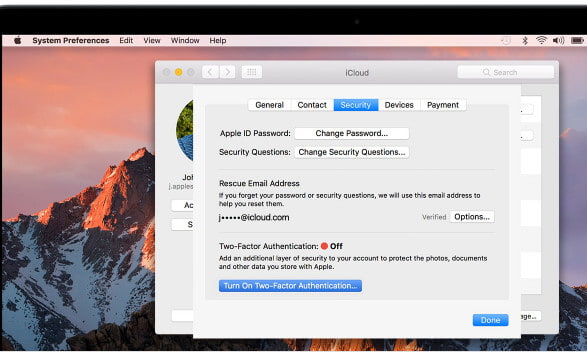

- #Turn off verification codes for mac high sierra how to#
- #Turn off verification codes for mac high sierra mac os#
- #Turn off verification codes for mac high sierra install#
(The drive should be at least the same size as your Mac drive.) Connect an external hard drive to your Mac and launch Time Machine. Here you have two options to backup Mac data before macOS 10.13/10.13.4 update: Time Machine or Mac backup software for help. Back up Mac computer data before macOS 10.13/10.13.4 update
#Turn off verification codes for mac high sierra how to#
Here Part 1, we'll show you how to upgrade to macOS 10.13/10.13.4 High Sierra without losing any data on MacBook Pro/MacBook Air/iMac etc.

Upgrade to macOS 10.13/10.13.4 High Sierra without losing data
#Turn off verification codes for mac high sierra install#
Follow the two next parts to free download macOS 10.13/10.13.4 to install and fix the macOS High Sierra update error right now.
#Turn off verification codes for mac high sierra mac os#
The software updates will be available for all eligible iOS devices and Macs in the fall.If you are trying to find a simple way to update Mac OS to the latest 10.13 or 10.13.4 High Sierra or you are looking for effective solutions to fix macOS High Sierra update stuck or failure error, you are at the right place. IOS 11 and macOS High Sierra public betas will be available in late June through the Apple Beta Software Program. Verification codes will be displayed on your trusted devices automatically whenever you sign in, and you will no longer need to keep a printed recovery key to make sure you can reset a forgotten password. Once updated, you'll get the same extra layer of security you enjoy with two-step verification today, but with an even better user experience.

This is our most advanced, easy-to-use account security, and it's required to use some of the latest features of iOS, macOS, and iCloud. If you install the iOS 11 or macOS High Sierra public betas this summer and meet the basic requirements, your Apple ID will be automatically updated to use two-factor authentication. The full text of the email is copied below: On iOS, users can still enable the Recovery Key as a backup method in Settings > Apple ID > Password & Security > Recovery Key. Two-factor authentication also displays a map on all trusted devices with an approximate location of where an Apple ID sign-in attempt occurred when a user is trying to access the account from an unknown device or on the web.Īpple's two-factor authentication method disables the Recovery Key by default, since offline verification codes can be generated on trusted devices in the Settings app. The two security methods are similar in many ways, but two-factor authentication automatically sends a six-digit verification code to all trusted devices registered to a given Apple ID, whereas two-step verification manually prompts users to send a four-digit code to any SMS-capable trusted device registered.

Two-factor authentication requires an Apple device with iOS 9, OS X El Capitan, watchOS 2, any tvOS version, or later. Apple recently emailed Apple ID users with two-step verification enabled to inform them that, upon installing iOS 11 or macOS High Sierra, they will be automatically updated to its newer two-factor authentication method.Īpple introduced two-factor authentication in 2015 as an improved version of its two-step verification method for securing an Apple ID account with both a password and a secondary form of verification.


 0 kommentar(er)
0 kommentar(er)
